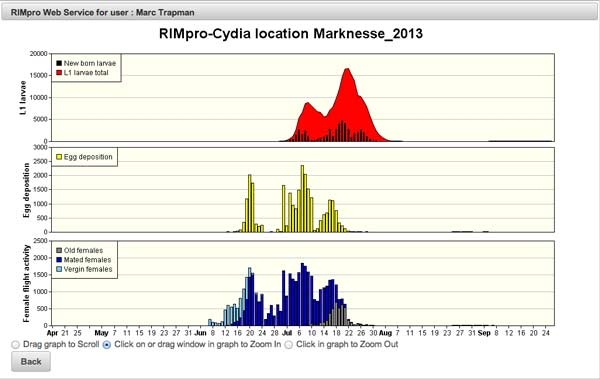Interpreting the graphs (continued from last month)
The bottom graph in Figures 1 and 2 shows the flight of the female moths.
Juvenile unmated females are shown in light blue, mated females in dark blue, and females that have laid all their eggs in grey.
The more females present and the more favourable the evening flight conditions, the higher the flight activity.
The middle graph shows the number of eggs deposited per day (yellow). Ovicidals like Insegar (fenoxycarb) and Dimilin (diflubenzuron) kill fresh eggs that are laid on top of the insecticide residue.
These products have to be applied just before a period of intense egg deposition.
The upper graph shows the hatching eggs. The small black bars represent the number of eggs hatching that day.
In red are all the larvae still in the first larval stage that can still be reached by larvicides.
Biological insecticide containing granulose virus (Madex, Carpovirusine) have only a few days of efficacy and should be timed accurately following egg hatching.
More potent chemical larvicides can be scheduled during the peaks in egg hatch.
Codling moth management
The codling moth population in an orchard develops over the course of years. This long-term development has to be recognized to plan the right strategy.
Management based on pheromone traps is quite problematic. The traps only show male moths looking for females, while it is the females that lay the eggs in the weeks after mating that we want.
Research has shown that there is no correlation between the time and number of male moths trapped, and the time or number of eggs laid by female moths. RIMpro has proven to be far more reliable.
Growers and consultants repeatedly find that there is no relationship between the number of moths trapped and the risk for damage. It is better to use the observations on damage in the previous year to estimate the population pressure for this year.
Assisting with mating disruption
In production areas where codling moth control is difficult, mating disruption has become a standard treatment.
Additional insecticides can then be limited to a few treatments just before the peaks in the egg hatching (red graph).
If no mating disruption is applied, several options are open.
We were very effective where we applied Insegar just before egg deposition, followed by treatments with granulose virus during the period of egg hatching.
In the absence of ovicidal treatments, the larvicidal treatments should be started earlier; not with the first egg hatching, but as soon as the number of hatching eggs increases.
These treatments are to be repeated while monitoring the next predicted peaks in egg-hatching and considering the properties of the insecticide used.
For more information, and contact details see Tree Fruit November 2014




















